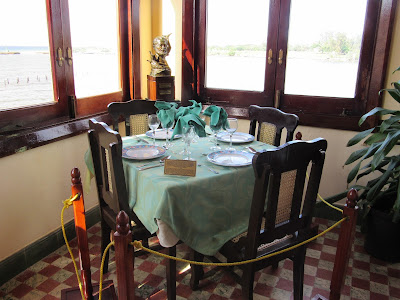One of the things I love to do when I travel is to visit the homes, haunts and graves of famous historical figures. On this trip I got my chance to see Ernest Hemingway's home, bar and fishing village located near Havana and it was truly inspiring.
 |
| the useless tower |

Hemingway had diabetes and needed to watch his weight carefully. In his bathroom, he faithfully recorded his poundage.
 Hemingway decided to breed cats, just as he had bred
peacocks on Key West. At one time the couple lived with 57 cats. There’s even a
small pet cemetery for his favorite ones: Black, Negrita, Linda and Neron.
Hemingway decided to breed cats, just as he had bred
peacocks on Key West. At one time the couple lived with 57 cats. There’s even a
small pet cemetery for his favorite ones: Black, Negrita, Linda and Neron. The pet cemetery is near the old tennis court, which after his death became the dry dock for his yacht, El Pilar, which he co-owned with Gregorio Fuentes. The two men had an agreement that when one couldn’t sail, the other would quit sailing, too.
I tried to feel the “spirit” of Hemingway at the finca, and I did, but it wasn’t in the
tower or in the house; it was near his yacht. I felt a joy and happiness there,
which made me believe that this boat was probably where he was his happiest
self. (As a writer, I can easily understand how any distraction from writing gives joy and happiness!)
 |
| Gregorio, model for Santiago in The Old Man and the Sea |
Told in four parts and based on real love letters and telegrams, Mrs. Hemingway reveals the explosive love triangles that wrecked each of Hemingway's marriages. Spanning 1920s bohemian Paris through 1960s Cold War America, populated with members of the fabled “Lost Generation,” Mrs. Hemingway is a riveting tale of passion, love, and heartbreak.
Hemingway was on good terms with the Cuban revolutionary
government. He had his picture taken with Castro and even officially presented
him with a trophy in the summer of 1960 for winning a sport fishing contest
named for Hemingway. However, when Hemingway went to Idaho to treat his severe
depression in early 1961, he and his wife could not return to Cuba because
their house had been expropriated, as all abandoned houses were under the new
Castro regime.
Hemingway committed suicide in Idaho on July 2, 1961. The
official Cuban government account regarding Finca
Vigía is that after Hemingway's death, Mary Hemingway deeded the home,
complete with furnishings and library, to the Cuban people. It was made into a
museum devoted to the author. Mary Hemingway negotiated with the
Castro government for certain easily movable personal property (some paintings
and a few books), plus manuscripts deposited in a vault in Havana. Most of
their personal property, however, had to be abandoned because there was no way
it could be moved out of the country at the time. We were told that the
furnishings and look of the house were kept as Hemingway left them.
Cojimar
 |
| Cojimar today |
 |
| the fishing village as it looked during Hemingway's time |
We continued our Hemingway journey by also going to Cojimar,
the fishing village, the setting for his novella, The Old Man and the Sea.
Hemingway won the Pulitzer Prize in 1953 for the book, and when he took the Nobel Prize in 1954, Cojimar became a bona fide tourist attraction. Hemingway docked his yacht, El Pilar, in Cojimar and fished here with his friend, Gregorio Fuentes, who became the model for the character of the old man in the book.
 Hemingway used to frequent La Terazza, a
restaurant/bar that faces an estuary that empties into the ocean. A corner table is enshrined and roped
off in his honor along with numerous photographs of Hemingway—and a picture of
Gregorio, who lived to be 101. For a 1.50 cuc, visitors can walk through the
place and get a daiquiri, a favorite drink of Hemingway.
Hemingway used to frequent La Terazza, a
restaurant/bar that faces an estuary that empties into the ocean. A corner table is enshrined and roped
off in his honor along with numerous photographs of Hemingway—and a picture of
Gregorio, who lived to be 101. For a 1.50 cuc, visitors can walk through the
place and get a daiquiri, a favorite drink of Hemingway. 
I'm not much of a drinker but I couldn't resist drinking a daiquiris in Hemingway's honor, especially since it was free. It was very delicious and very refreshing on this hot and humid summer day.
The daiquiri is the quintessential rum cocktail with rum, lime, and a sweetener.
The daiquiri is the quintessential rum cocktail with rum, lime, and a sweetener.

The town remembers Hemingway with a small gazebo that encircles a commemorative bust, sculpted from the melted down propellers donated by local fishermen. It was the first statue of him after his death It's about 40 yards down the street from La Terazza. The Cubans must have really liked this guy!!
Across from the gazebo is the amazingly photogenic Torreon de Cojimar, a Spanish fort built in 1649 and now used by the Cuban Coast Guard. It was the first fortification taken by the British in 1762 when they attacked Havana from the rear. I was fascinated by its compactness and its lines against the sea and sky.

BTW, Rotten Tomatoes announced the new movie soon to be out: Papa Hemingway in Cuba. It's the first Hollywood film made there in 50 years and it shows many of the places discussed in this blog. Here's the trailer.
http://www.imdb.com/title/tt2749282/








